Reserve Bank of Australia Annual Report – 1995 The Economy and Monetary Policy
The Australian economy recorded another year of solid growth in 1994/95, with real GDP rising by around 4¾ per cent. Since the last cyclical low point in mid 1991, output has expanded by about 15 per cent. Employment, which began to recover some time after output, has risen by over 650,000 since late 1992, and the rate of unemployment has fallen by almost 3 percentage points. Over this recovery phase, Australia has enjoyed the lowest rate of inflation for a generation, averaging around 2 per cent in underlying terms. These outcomes have been consistent with the broad objectives of monetary policy, which are to foster sustainable growth in output and employment and to hold the underlying rate of inflation to around 2–3 per cent over time.
Although slowing through the year, the economy continues to grow at rates supportive of further increases in employment. Pressures on inflation, however, have been rising. Cyclical pressures on costs and prices began to emerge as the slack in the economy was taken up. Most domestic costs of businesses – labour, services, raw materials and other inputs – increased at a faster rate. In addition, a fall in the exchange rate for the Australian dollar during the second half of the year pushed up costs of imported inputs and final products. These effects have been slow to show up in prices to the consumer, but they are now emerging more clearly. The tightenings in monetary policy during the year – the first increases in short-term interest rates for five years – were implemented to moderate inflationary pressures and to forestall a further build-up. In that way they were intended to help lay a solid foundation for durable growth in activity and employment.

Some major economic indicators
|
Average over 10 years to 1991/92 |
1992/93 |
1993/94 |
1994/95 |
|
|---|---|---|---|---|
| Growth in real GDP* | 2.7 | 4.1 | 4.7 | 3.7+ |
| Unemployment rate** | 8.3 | 11.0 | 9.9 | 8.3 |
| Underlying inflation* | 6.6 | 1.8 | 2.0 | 2.5 |
| * Year to June quarter ** At June + Year to March quarter 1995 |
||||
The current account deficit widened sharply during 1994/95, to 5¾ per cent of GDP. This was partly cyclical, and partly a reflection of exogenous factors, such as the drought and increases in world interest rates. Even allowing for these factors, however, the widening current account deficit exposed again a chronic tendency for undersaving by Australians which has to be addressed if living standards are to be improved over the long term. Recent Government initiatives will, in time, go a long way towards alleviating this problem but they will almost certainly need to be followed up by complementary measures.
Economic developments abroad
External conditions were mixed in 1994/95, although reasonably favourable overall to Australian businesses. Growth in Australia's major trading partners, in aggregate, was about 4½ per cent, which was similar to that in the previous year. Once again, growth in the countries in non-Japan East Asia, which take about one third of Australia's exports, stood out; they averaged growth of around 8 per cent, about the same as in the preceding year and nearly three times that of OECD countries.
Within this group, both the Republic of Korea and Singapore have seen particularly strong expansions, with growth rates in double digits at times over the past year. Hong Kong and Taiwan both have seen steady growth at around 6–7 per cent over recent years. Inflation performances vary widely among these countries. The gradual appreciation of the Singapore dollar against the US dollar has helped to contain inflation to around 3 per cent for most of the past four years. In Hong Kong, where the centrepiece of monetary policy is a fixed exchange rate to the US dollar, inflation is running higher, at around 9 per cent. The Republic of Korea has kept inflation around an average of 5½ per cent over the past three years. The People's Republic of China, which is now one of Australia's largest trading partners, continued to grow at double-digit rates over the past year. This has been accompanied by inflation rates in excess of 20 per cent, which restrictive policies, including credit controls, are now beginning to slow a little.

Most of the large English-speaking countries saw the business cycle upswing continue. In the United States, real GDP grew at an annual rate in excess of 4 per cent through to the end of 1994. Indicators of capacity utilisation reached historically high levels, and unemployment fell through levels usually thought to be associated with rising inflation. This prompted the Federal Reserve to tighten monetary policy; by February 1995, short-term interest rates in the US had risen by around 3 percentage points from their low point. The same broad pattern was observed in other English-speaking economies. In Canada, the United Kingdom and New Zealand, as well as in Australia, the emergence of cyclical pressures prompted upward adjustments to short-term interest rates by the respective central banks, aimed at heading off any upsurge in inflation. The largest adjustment occurred in New Zealand, where monetary policy seeks to maintain underlying inflation between 0 and 2 per cent at all times.

In the US, signs of higher price increases were slow to emerge, at least at the consumer level. By mid 1995, the rate of increase in consumer prices had picked up a little, as had labour costs. By that time, however, the rate of growth of output had moderated, and the pressures on prices lessened. This gave the Federal Reserve confidence to lower interest rates slightly in July. Current prospects are for a lengthy period of moderate expansion in the US, which would contribute to a favourable environment for world growth. In other English-speaking countries, inflation has moved up a little, although underlying rates remain in the 2–3 per cent region.

The Japanese economy largely stood still. Industrial output moved ahead, but by May 1995 it was still well below its pre-recession peak recorded four years earlier. The economy as a whole recorded growth of only 0.6 per cent for the fiscal year to March 1995. One factor holding the economy back was the lingering after-effects of the bursting of the 1980s asset price bubble, with parts of the financial system experiencing distress, and many banks facing rising levels of bad loans. Land prices drifted lower. Deflationary pressure on prices for goods remained in evidence, with wholesale price measures falling for the fifth successive year; prices for consumer goods were steady over the year to June. High levels of the yen also contributed to these deflationary pressures, as well as to the problems confronting many exporters. The Kobe earthquake in January 1995, which destroyed a large number of dwellings and damaged infrastructure in the region, disrupted production. Not surprisingly given these developments, Japanese business confidence has remained at a low ebb. Both monetary and fiscal policy were eased on several occasions during the course of the year, with short-term interest rates reaching historical lows and the budget deficit expanding to around 4 per cent of GDP.
Economic growth in Australia's trading partners
(Growth in real GDP; per cent)
|
Share of Australian exports+ |
1993/94 |
1994/95 |
|
|---|---|---|---|
| United States | 8.5 | 3.5 | 4 |
| Japan | 25.4 | 0.0 | ½ |
| European Union | 12.3 | 1.0 | 3¼ |
| Non-Japan East Asia* | 32.4 | 8.2 | 8 |
| New Zealand | 5.7 | 6.4 | 5½ |
| Total trading partners | 4.2 | 4½ | |
| + Average for 1991/92–1993/94 * People's Republic of China, Hong Kong, Indonesia, Malaysia, Philippines, Singapore, Republic of Korea, Taiwan, Thailand |
|||
The German economy continued its gradual expansion in 1994/95. This has relied heavily on exports, although part of the rise in output has also come from inventory accumulation. Consumer demand has been quite weak. A modest reduction in interest rates was made possible by the return of inflation rates to levels more in line with the Bundesbank's objectives.
Performances elsewhere in Europe have been mixed, although growth was generally a little stronger over the past year. The United Kingdom, which withdrew from the Exchange Rate Mechanism in 1992, has experienced stronger growth than most other European countries since that time, but has seen higher inflationary pressures lately. Spain and Italy, which also allowed their currencies to depreciate during the ERM crisis, have recorded higher inflation as well, although mostly only sluggish growth. Those countries with the strongest ties to the German mark, such as the Netherlands, Belgium and France, have recorded moderate recoveries over the past year, with continued low inflation. High rates of unemployment remain common in Europe; for continental Europe, unemployment is estimated at about 11 per cent of the labour force, only marginally lower than a year ago.
The past year was again punctuated by periods of considerable instability in financial markets. The main developments – including the rise and fall of bond yields and the re-alignment of the major currencies – are detailed in the next chapter.
Another significant development was the financial crisis which engulfed Mexico. Over recent years, the Mexican authorities had wrought numerous economic reforms, and seemed to be making good progress towards macroeconomic stability. The country's current account deficit, however, increased sharply in the early 1990s, in part a legacy of using a high exchange rate strategy to dampen inflation. The financing counterpart of this deficit involved substantial inflows of portfolio investment from American mutual funds. As the credibility of the high exchange rate strategy was undermined during the second half of 1994, borrowing terms became increasingly unfavourable, to the point where the Mexican government was obliged to conduct much of its borrowing in US-dollar-denominated claims, rather than pesos. When the situation became untenable, and the Government acted to correct the over-valuation of the exchange rate by devaluation, this triggered a crisis in financial markets. The peso promptly dropped by around 40 per cent against the dollar and Mexican interest rates were pushed to levels of 80 per cent and higher to contain the slide. Other domestic policies were tightened abruptly.
Muted echoes of this episode spread to some other Latin American economies. Further afield, other countries (including Australia) confronting large budget or current account deficits were subject to increased scrutiny by international financial markets. In several cases – such as Canada, Italy and Sweden – domestic policy settings were tightened in response to exchange rate pressures. These experiences provided another reminder of the vulnerability of countries with relatively large foreign liabilities to sometimes sudden swings in sentiment in world financial markets.
Economic developments in Australia
The stronger domestic growth pattern – which first emerged in the latter months of 1993 – was even more in evidence throughout 1994. Economic activity surged ahead, aided by a firming international environment, heightened confidence and supportive domestic macroeconomic policies. Over the year to the September quarter 1994, real GDP rose by around 6 per cent, notwithstanding the serious drought in the eastern States. In the non-farm sector, the rate of growth over the same period was around 7 per cent.
This growth was driven principally by domestic demand, with all categories of private spending picking up. Households, other than those affected by the drought, enjoyed their strongest growth in incomes for several years. Consumption expenditure rose commensurately, and for 1994/95 as a whole looks to have recorded its strongest growth for about 20 years. Indeed, consumer demand tended to outpace income growth for a time, as households increased their borrowing and reduced their saving.

Residential investment rose further, and a rapid pace of housing construction was maintained, with commencements of new dwellings running at an annual rate close to 180,000 units in the second half of 1994. The upswing in housing was also longer-lasting than in most other cycles. By the end of 1994, some 500,000 new private dwellings had been constructed since the last cyclical low point in housing activity in 1990/91. This was the highest rate of construction in any four-year period for more than 20 years; the last comparable increase in the supply of dwellings occurred in the upswing which finished in 1973. The large increase in dwelling construction was facilitated by improved access to credit markets, a result both of a decade of financial liberalisation and innovation and a return to much lower nominal interest rates.
The sustained burst of construction boosted the stock of dwellings by about 9 per cent in the four-year period – well in excess of the growth in population – and set the scene for a sharp slowing in the rate of home building. Historically, housing activity is characterised by wide swings around an upward trend set by demographics, such as household formation. By late 1994, these underlying demand factors were suggesting that a correction was overdue. The financial counterpart – housing credit – has mirrored the rapid rise and subsequent return to more normal levels of demand. The outstanding stock of housing credit increased by almost 50 per cent in the two years to December 1994. Since then, the rate of growth of credit and the value of new loan approvals have fallen substantially, to around their historical norms.

Business investment was slower to get under way in this recovery, but surged during 1994. In the year to December 1994, spending on plant and equipment increased by over 30 per cent in real terms, and revisions to earlier data point to stronger investment in earlier periods than had been indicated initially. Business spending on buildings and structures, which had been quite weak for several years, also began to pick up, particularly in the construction of shops and some other service areas. Several major infrastructure projects also commenced, boosting spending on engineering construction. This stronger investment performance had been anticipated, given the existence for some time of sound fundamentals – including rising capacity utilisation, strong business profitability, falling debt burdens, relatively low interest rates, good sales growth, and high levels of confidence.

Public expenditure contributed to growth. The 1994/95 Federal budget brought down in May 1994 (together with the Working Nation statement) was mildly expansionary, with discretionary policy adjustments estimated to be equivalent to a quarter of 1 percentage point of GDP in that year, and a little more in later years. State budgets overall also generated increased spending, on the back of higher revenues. On latest estimates, real public final expenditure increased by over 5 per cent in 1994/95. The Federal Government's latest budget, brought down in May 1995, is estimated to be mildly contractionary, to the extent of about one half of 1 percentage point of GDP in 1995/96.

The strong increase in output saw a corresponding lift in employment, and a sharp fall in unemployment. In fact, employment growth continued to strengthen well into 1995, even after most other indicators suggested that output growth was slowing. Over the year to June 1995, total employment rose by 4.8 per cent, a rate of growth equal to any seen in the business cycle expansions of the 1980s. The growth was concentrated initially among part-time workers but, by early 1995, full-time workers were also sharing in the expansion.
By June 1995 unemployment had fallen to 8.3 per cent of the labour force, compared with around 10 per cent a year earlier and a peak of over 11 per cent in late 1992. The incidence of long-term unemployment (defined as persons unemployed for at least a year) also declined, falling both as a share of the total labour force and of the total unemployed. This improvement might owe something to the new labour market programs targeting the long-term unemployed but, as of early 1995, those programs were still in a relatively early stage of implementation. Most of the improvement to date – in both long-term and overall unemployment – appears to owe more to sustained economic growth and moderation in wage claims over recent years. Whatever the precise reasons, the outcome is much better than was widely expected a couple of years ago, when pessimism about employment prospects was at its height.
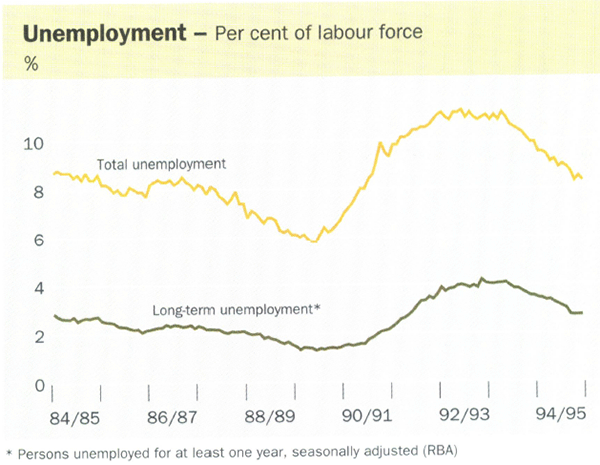
As welcome as these developments were, the pace of growth in 1994 warranted careful attention from a monetary policy perspective. Growth in output at rates of 5–6 per cent – and even faster for non-farm production, and faster still for expenditure – cannot be sustained for long in the Australian economy before running into short-term constraints and, inter alia, exacerbating inflation tendencies. Although investment was moving to increase physical capacity in goods-producing industries, output was rising somewhat faster in the short term, and most measures of capacity utilisation reached relatively high levels by the end of 1994. Unemployment was still at high levels (around 9 per cent) but the labour market was tightening at some speed and shortages of certain skills were beginning to emerge. In these circumstances, concerns about the size of wage and salary increases began to surface, underpinned by seemingly large rises as a result of high-profile campaigns in several areas.
The perceived inflationary risks of the strong growth helped to hold up long-term interest rates. Ten-year bond yields remained above 10 per cent during the second half of 1994, reflecting market expectations that inflation could rise (and stay) above the authorities' objective. While long yields rose in most countries during 1994, the rise in Australia was relatively large by international standards, suggesting some Australia-specific concerns to the markets. It was no coincidence that countries with poor long-term records on inflation, or with large fiscal or current account deficits, tended to record the largest increases in bond yields. The same concerns fueled expectations of adjustments to monetary policy, causing market interest rates for short and medium-term maturities to rise.
The Bank did not share the degree of pessimism exhibited by financial markets. It was, nonetheless, committed to holding the line on underlying inflation – in the interests of sustaining the recovery – and that argued for policy adjustments to be made early and decisively. By August 1994, the short-term interest rate structure, which had been established a year earlier in quite different circumstances, had clearly done its job. Those interest rates were, in nominal terms, the lowest for a generation. In “real” terms – that is, relative to the prevailing rate of inflation – they were about the same as at the previous cyclical low points in the 1980s. They were appropriate for an economy recovering gradually from a pronounced slowdown with deflated asset prices and falling expectations about inflation; in the much more confident mood which had emerged by the middle of 1994, however, they were too low.
Cash rates were raised by three quarters of a percentage point in August. This was followed by two further adjustments, each of 1 percentage point, in October and December. These increases took cash rates to 7½ per cent.
| 17 August 1994 | +¾ |
|---|---|
| 24 October 1994 | +1 |
| 14 December 1994 | +1 |
Perceptions of the strength of activity reached their peak at about the time of the December tightening. Financial markets at that time anticipated several further increases in interest rates, with the structure of short-term interest rates implying expectations of a rise in cash rates to levels above 10 per cent over the ensuing year. These and similar market expectations were picked up by media and other commentators.
By the early months of 1995, however, some signs of slowing in the economy were beginning to emerge. These were most evident in measures of sentiment in business and consumer surveys, which fell back noticeably in the wake of the interest rate rises. By February, for example, the Westpac-Melbourne Institute index of consumer sentiment had fallen by 27 per cent from its peak in June 1994, although it has recovered somewhat subsequently. The fall in business confidence measures was similarly marked. Broader indications of slower growth began to emerge in slightly softer data for retail spending and imports; employment, if anything, picked up even more strongly, but vacancy data suggested that a slowing was in prospect. The March national accounts data also showed a slowing in demand and output. Overall, the three pre-emptive increases in cash rates appeared to be having their desired effect of dampening growth.
This apparent responsiveness of the economy to monetary policy was a feature of developments in 1994/95. By past measures, the level of interest rates reached by December could not be said to constitute a particularly tight monetary stance. For one thing, the rises in cash rates took them to levels still well below the average for the previous decade, in nominal terms. Even in “real” terms, interest rates were not unusually high. Moreover, most lending rates rose by roughly 1 percentage point less than the increase in cash rates. Even though households are carrying more debt today than they were five years ago, it is hard to believe that the rises in interest rates, on their own, constituted a major contractionary force on the economy.
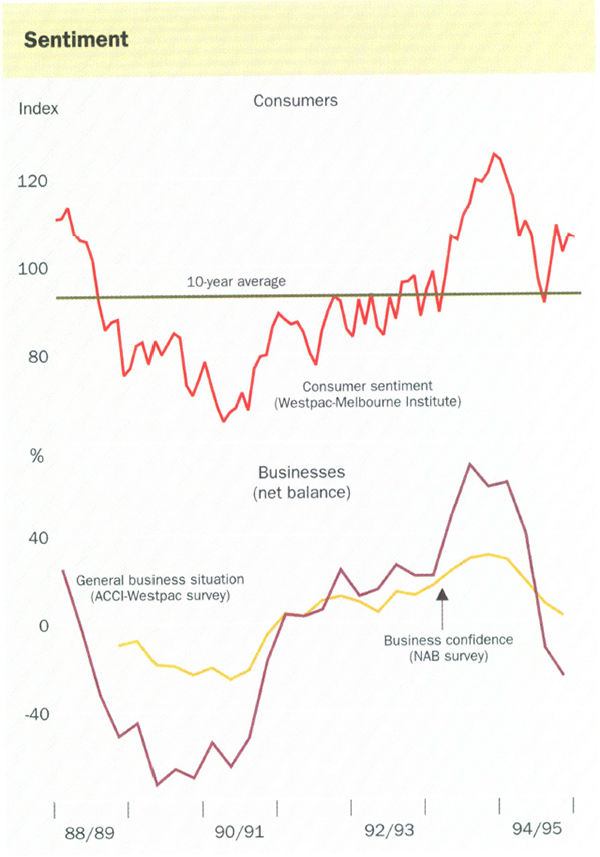
To what, then, can the apparent response of sentiment and activity to the increases in cash rates be ascribed?
Several factors appear to be important. One was that some of the slowing was less the result of policy changes than of the inevitable working-out of the business cycle. The exceptional strength of growth in the early phase of a recovery is seldom sustained over a long period. Even at the time when assessments of growth were at their most bullish, some elements of a slowing were already coming into place. The housing cycle, for example, was peaking and, with excess supply starting to emerge, the pre-conditions for a cyclical fall in residential construction activity were present; the moderate rise in housing interest rates has reinforced – rather than caused – this adjustment. In addition, the rate of stock accumulation had picked up, to keep stock levels in line with higher sales, but this contribution to output growth could not be sustained. Finally, the full impact of the drought had not, at that stage, been felt. These factors made it unlikely that the very high growth rates recorded during the first three quarters of 1994 would have been sustained anyway.
Secondly, the public manner in which policy adjustments are announced these days may have contributed to a more pronounced response. The Bank's practice over the past six years has been to announce changes in interest rates in a very public way, and to explain the reasons for the decisions. This makes it quite clear to everyone what is happening, and why, in contrast to the less transparent practice followed in the previous period of rising interest rates in the late 1980s. In this, the Bank is more open than most central banks about its thinking and intentions. A third factor appears to have been the commonly (although not universally) held perception among commentators that further rate rises were in prospect, reviving memories of the high levels of interest rates reached in the late 1980s.
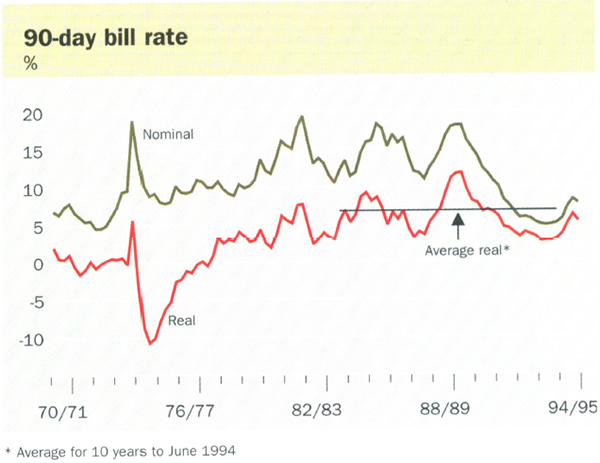
Signs of confirmation that the economy was slowing caused a re-appraisal of the outlook for interest rates, and the emergence of an expectation that the peak might have been reached for the time being. This process was aided by an apparent slowing in the US economy, which shifted expectations about the course of economic policy in that country, and by the Federal budget in May, which incorporated a modest degree of fiscal tightening. The premium attached to bill rates above cash rates (indicating expectations of a policy tightening), which had existed since early 1994, was wound back, and had disappeared entirely by June 1995.
Inflation
To date, the rate of consumer price inflation has remained quite low. Over the year to June 1995, underlying inflation as measured by the Treasury's series was 2½ per cent. This was higher than in the preceding year, but marked a fourth year of underlying inflation of 2–3 per cent.
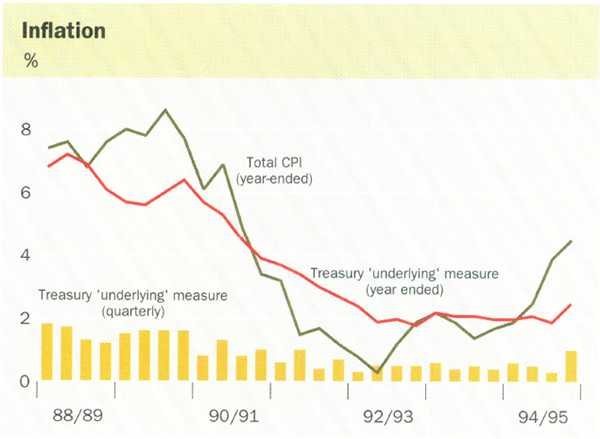
The Consumer Price Index (CPI) increased by 4.5 per cent through 1994/95, compared with 1.7 per cent through 1993/94. Several factors contributed to this faster rate of increase, including the drought which pushed up some food prices in the first half of 1995, and tax increases by both Commonwealth and State governments on cigarettes and tobacco, petrol and motor vehicles. The dominant factor, however, was the effect of higher mortgage and consumer interest costs, which were, in turn, a direct result of the three increases in cash rates during the second half of 1994. Excluding interest charges, the rise in the CPI over the year to June was 3.2 per cent.
Insofar as the CPI is attempting to measure costs associated with households' actual outlays, the inclusion of interest costs in the CPI can be defended. This is not, however, the appropriate measure for analysing price trends from the perspective of monetary policy, nor is it the appropriate price measure to focus on in price-setting and wage negotiations.
For monetary policy purposes, what is needed is a measure which reflects the responses of prices to the balance of demand and supply forces in the economy. The headline CPI does not measure this. Given the preponderance of floating-rate mortgages in Australia, the sensitivity of mortgage rates to cash rates and the weight of mortgage costs in the CPI, changes in monetary policy have a pronounced mechanical effect on the CPI. It would obviously be inappropriate for monetary policy, in seeking to control inflation, to respond to changes in the CPI that were the direct result of earlier policy adjustments. Similarly, the wrong signals would be given during the phase of the cycle when interest rates were falling. Over the past five years, therefore, the Bank has referred consistently to “underlying” inflation, including during the period when interest rates were falling and pushing the CPI down. Over an extended period, both measures can be expected to give much the same result, with falling interest rates in some periods offsetting rising interest rates in other periods. At key points in the cycle, however, the published CPI gives the wrong signals for monetary policy.
This problem is not unique to Australia, although the combination of the statistical treatment of interest rates in the CPI and the importance of short-term interest rates (rather than longer-term rates) for housing mortgages does make the distortion greater for Australia than for most countries. It could be addressed by calculating the CPI differently, as a number of countries do, using measures of housing rents (rather than interest rates) to reflect the price of housing services. Alternatively, interest rates and other volatile components can be excluded from the published index to provide a measure of “underlying” inflation.
Different approaches can be used to measure underlying inflation. Some rely on excluding inappropriate items from the index, while others remove outlying observations of any kind. The Bank has investigated these different approaches. None is ideal; each has its own strengths and weaknesses. Over the past several years, however, the various measures show a similar picture of underlying price trends. (These issues are canvassed in more detail in the Quarterly Report published in the Bank's July 1995 Bulletin.) The Bank has chosen to focus on the Federal Treasury's underlying series, which has the advantages of being well-known, having a long history and being published by the ABS as part of its release on the CPI.
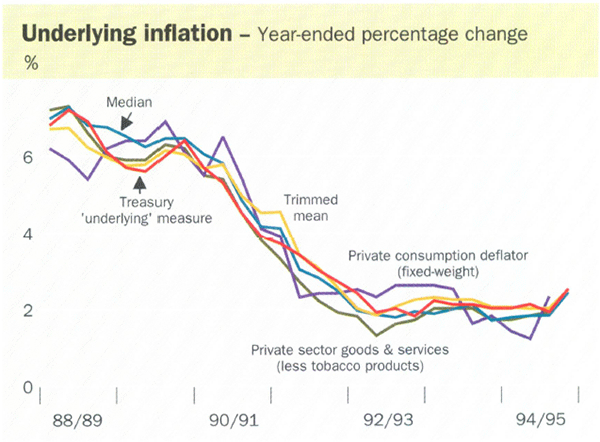
The good performance on inflation to date has been maintained, notwithstanding the significant lift in growth which occurred in 1994. This outcome has been helped by the structural and other changes occurring in the Australian economy, which have delivered better productivity performances and a more cost-conscious culture. If they can be sustained, these changes will, in due course, help to deliver higher living standards.
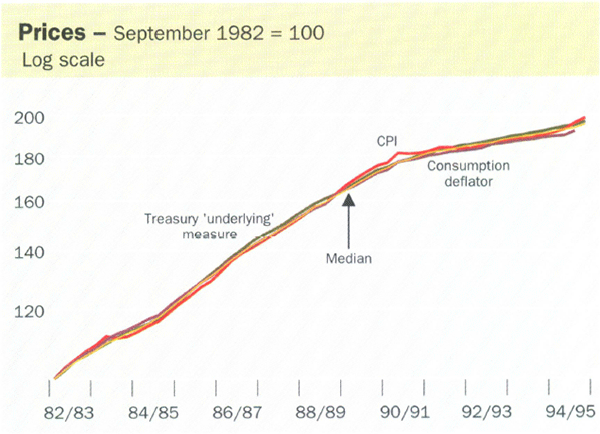
During the past year, however, it became apparent that inflation could not be sustained at acceptable rates without some slowing in the pace of growth. Potential growth rates are imprecise concepts, but such a rate for Australia is unlikely to be more than 3–4 per cent in the absence of further – and sustained – improvements in productivity. Such a rate is sometimes compared unfavourably with the higher growth rates of east-Asian economies. Those economies, however, differ in many important respects from Australia. For one thing, they have much higher levels of saving and investment. They are also at a stage in their development where they are still benefiting from the transfer of technologies from the older industrialised economies. In Australia, increased national savings and ongoing “microeconomic reforms” hold out the possibility of faster growth in productivity and living standards over the years ahead. In the meantime, attempts to sustain growth rates noticeably above 4 per cent carry significant risks. For much of the past couple of years, growth has exceeded this rate by a considerable margin. This was appropriate for a time, given the slack which existed in many areas of the economy, including the labour market. Towards the end of 1994, however, much of the excess capital capacity had been taken up, and the remaining margin was being steadily eroded.
Selected price and cost measures
(Percentage change over year to quarter or month shown)
| June 1992 | June 1993 | June 1994 | Latest | |
|---|---|---|---|---|
| Consumer prices | ||||
| Consumer price index | 1.2 | 1.9 | 1.7 | 4.5(1) |
| Private consumption deflator # | 2.4 | 2.6 | 1.8 | 2.3(2) |
| Treasury underlying measure | 2.7 | 1.8 | 2.0 | 2.5(1) |
| Producer prices | ||||
| Manufacturing prices* | ||||
| Raw material inputs | 2.3 | 0.7 | 3.3 | 7.2(3) |
| Intermediate goods | ||||
| – domestic | −1.8 | 1.2 | 1.5 | 7.0(3) |
| – imported | 1.2 | 8.5 | −3.0 | 10.7(3) |
| Final products | ||||
| – domestic | 2.2 | 2.4 | 1.3 | 2.9(3) |
| – imported | 3.5 | 12.8 | −3.2 | 4.0(3) |
| Building prices | ||||
| House building materials | −0.3 | 4.2 | 3.7 | 3.1(3) |
| Other building materials | −1.0 | 1.3 | 1.9 | 3.0(3) |
| Broader measures | ||||
| Domestic final demand deflator # | 1.8 | 2.6 | 1.4 | 1.9(2) |
| Gross Domestic Product deflator # | 1.5 | 1.3 | 1.4 | 2.4(2) |
| Nominal labour costs | ||||
| Average weekly earnings | 4.2 | 2.6 | 2.8 | 2.8(3) |
| Total ordinary-time earnings | 4.7 | 1.8 | 3.3 | 4.8(3) |
| Private sector ordinary-time earnings | 4.4 | 1.1 | 3.5 | 5.6(4) |
| Unit labour costs** | 2.2 | −0.5 | 0.5 | 3.3(2) |
|
# Fixed weight index Sources: Australian Bureau of Statistics, Commonwealth Treasury and Reserve Bank |
||||
The early signs of a cyclical build-up in producer prices were also in evidence during 1994, with the stronger growth in the world economy boosting commodity prices, particularly for oil and base metals. The impact of these developments on prices in Australia was muted initially as the Australian dollar appreciated significantly over the second half of 1994, but this was reversed in the first half of 1995. The effects of the lower Australian dollar have begun to feed through recently into import prices and domestic costs. Overlaid on this has been an increasing contribution from the impact of the drought on agricultural products. Grain prices have risen sharply since mid 1994, pushing up some product prices further down the production chain – bread prices, for example, have risen, along with prices of pork and poultry (which are predominantly grain-fed). This process could have further to go as farmers embark upon herd-rebuilding, pushing up live animal prices.
More generally, the price of raw materials used in manufacturing industries and the price of domestically produced intermediate goods rose by around 7 per cent over the year to May. Imported intermediate goods prices have been affected noticeably by the fall in the exchange rate, jumping more than 10 per cent over the year to May.
The pick-up in the price of final manufactured goods has been smaller, suggesting that cost pressures, in part, have been absorbed by producers, or offset by productivity gains elsewhere. Domestically produced and imported final manufactured goods prices rose by 2.9 per cent and 4.0 per cent, respectively, over the twelve months to May – more moderate but up on the increases recorded a year earlier.
These measures of producer prices, especially those for raw materials and intermediate goods, are volatile, and temporary periods of faster growth in them are not always reflected fully in higher consumer prices. Current and prospective demand conditions, however, suggest a substantial pass-through can be expected on this occasion. Import prices also could have further to rise, in the short term, as the falls in the exchange rate during the first half of 1995 feed through. The full effect on consumer prices of all these movements will take time to show up, but some upward pressure is likely over the next year or two, although an early and sustained recovery in the exchange rate would provide some offset.
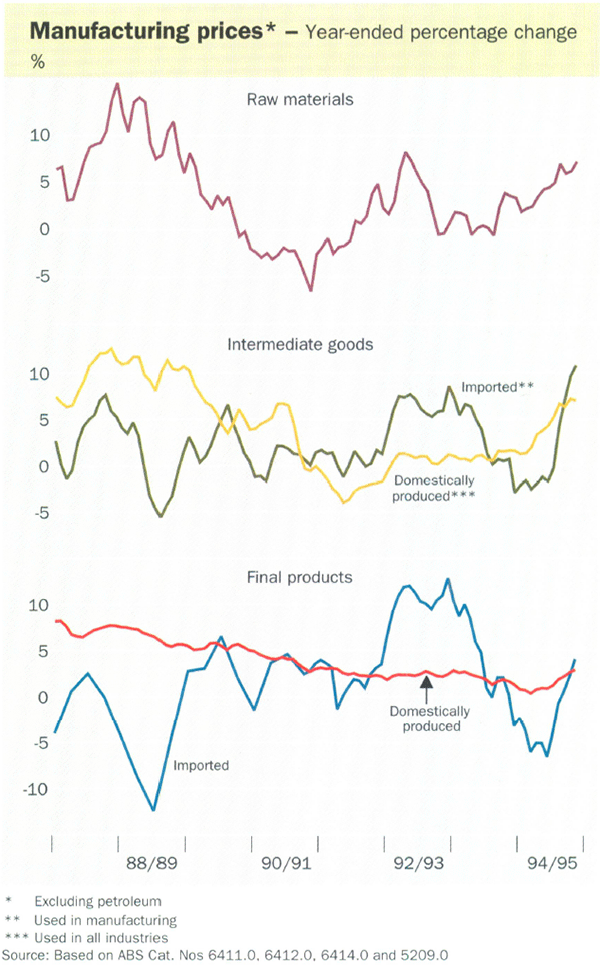
In the labour market, unemployment remains well above the point at which serious inflationary pressures are likely to be experienced. The relatively rapid speed of its fall over the past two years, however, has been such as to prompt a pick-up in labour costs. This is apparent from several sources. The size of settlements in enterprise bargains, which continued to spread across the workforce, was larger than in the previous year. The metals area in particular, where productivity growth has been exceptionally strong over recent years, saw a distinct pick-up in wage growth. Earnings statistics indicate that large increases occurred also in the transport, construction and wholesale sectors. Average weekly ordinary-time earnings for all employees showed a rise over the year to May of 4.8 per cent, compared with 3.3 per cent over the year to May 1994. In the private sector, where earnings tend to be more responsive to the business cycle, the pick-up appears to have been somewhat larger (although data here are less timely). Indicators of managerial and executive salaries show slightly higher increases than for the overall average. While different measures show differing rates of growth for wage and salary costs, all show some acceleration in the past year.
With business costs – labour, raw materials, intermediate inputs, and imported products – all rising faster, it would be surprising if prices to the consumer, measured in underlying terms, did not also pick up more quickly over the coming year. These pressures could be heightened by the impact of indirect tax measures. This prospect is being reflected in businesses' expectations about their own prices, as reported in surveys. Economic forecasters, too, are anticipating increased inflation, at least for the short term. Long-term security yields, although now well below their recent peaks, still appear to anticipate inflation rates above recent outcomes.
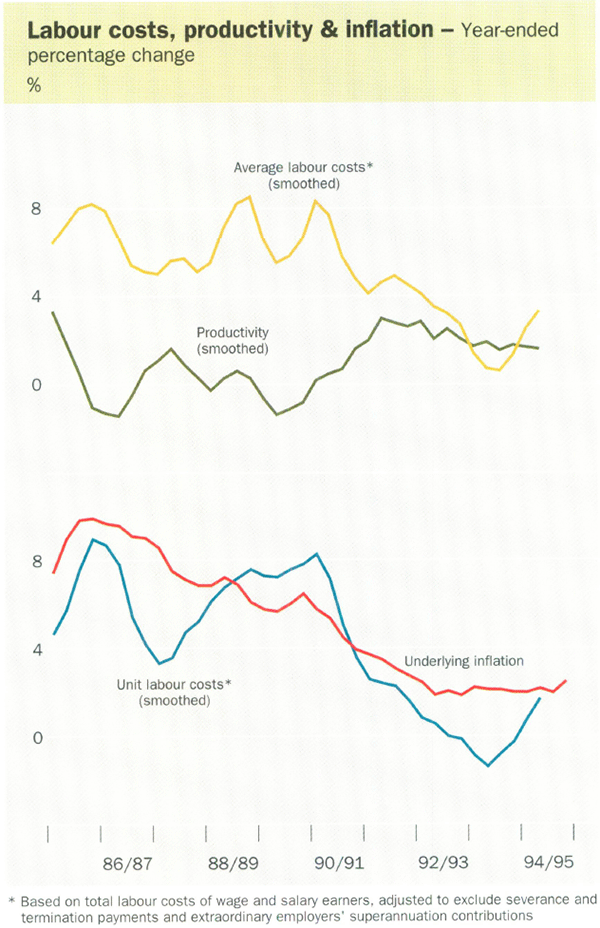
Some pick-up in inflationary pressures was to be expected in conditions of stronger growth and higher demands on real resources. It would be unrealistic to expect that inflation could be held to within narrow bounds through all stages of the cycle. Monetary policy in Australia is looking to deliver an appropriate medium-term performance, rather than to “fine-tune” inflation over the short term. An important key to that, however, is locking in the mentality of low expected inflation, especially given Australia's legacy of high inflation over a long period in the past. This, in turn, means dealing effectively with cyclical pressures as they arise.
From this perspective, the main concerns for policy in 1994/95 were twofold. One was to avoid the cyclical pick-up in labour costs gathering too much momentum and prejudicing our longer-term inflation performance. A second concern was that a lower exchange rate, if sustained, could exacerbate domestic inflationary pressures, adding to the difficulty of recovering the situation.
Both these concerns remain at the present time. The slower rate of growth in demand and output gives some cause for comfort, in that the cyclical forces making for higher domestic inflation should be abating in the period ahead. The round of cost increases presently going through the economy, however, is likely to push underlying inflation above 3 per cent over the year ahead. For that to be temporary, there can be no further pick-up in the growth of labour and staff costs, and the more subdued growth path now being followed will need to be reflected in some moderation in wage and salary claims over the coming year. The incorporation of the 2–3 per cent inflation objective into the Accord VIII agreement, which is a very welcome endorsement of that objective, should be helpful in this regard.
The recent low levels of the exchange rate, were they to continue, would clearly be unhelpful from an inflation perspective. The prospect of domestic price and cost pressures easing as the economy slows helps to make that situation tolerable for a time, as does the partial recovery of the exchange rate during July. Even so, movements in cost pressures, and in the exchange rate, will obviously warrant careful monitoring over the year ahead.
The balance of payments
Australia's terms of trade remain at historically low levels, although there was a small rise of 3½ per cent over the year to March. Metal prices in particular improved during the second half of 1994, only to give up some of that improvement in the first half of 1995 as US growth slowed. Overall, commodity prices can best be characterised as having firmed a little during 1994/95. But in SDR terms they remain 24 per cent below the peak levels of the late 1980s, and much lower than might have been expected, given the recovery in world industrial production over recent years. Still-large stockpiles of many base metals explain part of this story. For domestic producers, however, the low average value of the Australian dollar over recent years has largely offset this weakness, so that in Australian dollar terms, average commodity prices are now comparable with those at the height of the last commodity price boom in 1990. In other words, the floating exchange rate has helped to cushion, to a considerable extent, the export sector from the weakness in world prices.
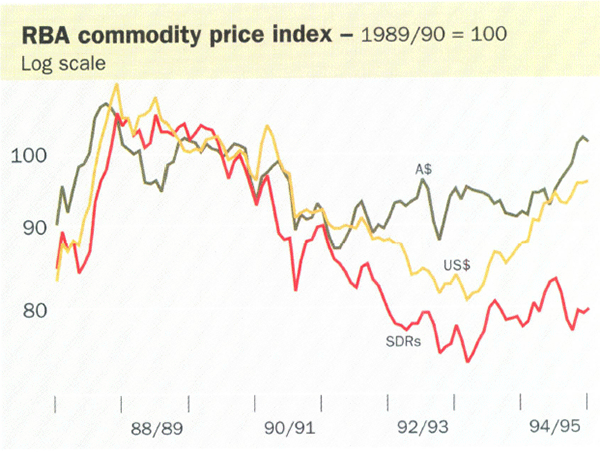
The balance of trade moved substantially into deficit during 1994/95. Imports expanded sharply under the influence of strong domestic demand, and exports slowed, in part because of the effects of the drought. The balance on goods and services was in deficit by about $9 billion, compared with $1 billion in 1993/94. In volume terms, imports are estimated to have risen by around 17 per cent; imports of capital and intermediate goods are estimated to have increased by 33 and 16 per cent, respectively, while consumption imports rose by 15 per cent. The growth in service imports was lower, at 9 per cent.
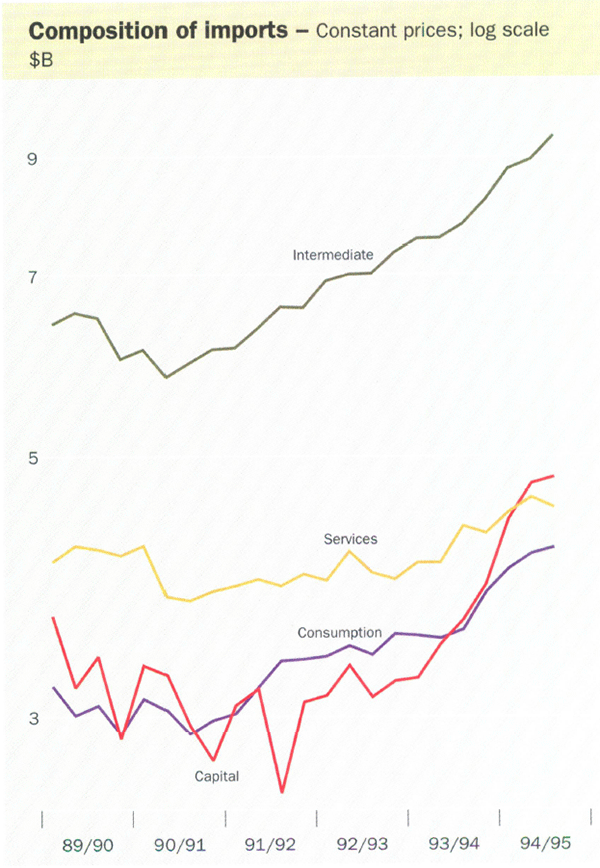
Export volumes of agricultural produce fell by around 4 per cent, with cereals particularly hard hit by the effects of drought. Grain production was almost halved last season. Boosted by strong increases in the prices of wool, sugar and grains, the rural component of the commodity price index rose by 11 per cent in SDR terms in 1994/95. Exports of manufactured goods continued to grow rapidly overall, despite an apparent slowing in the second half of 1994 when the potential for diversion into a strongly growing domestic market was greatest. Nonetheless, their average rate of growth of 16 per cent over the nine years since 1985/86 was maintained in 1994/95. Both resources and manufactured exports have increased their share of total imports into Asia from outside that region over recent years, the latter from a still very small base.
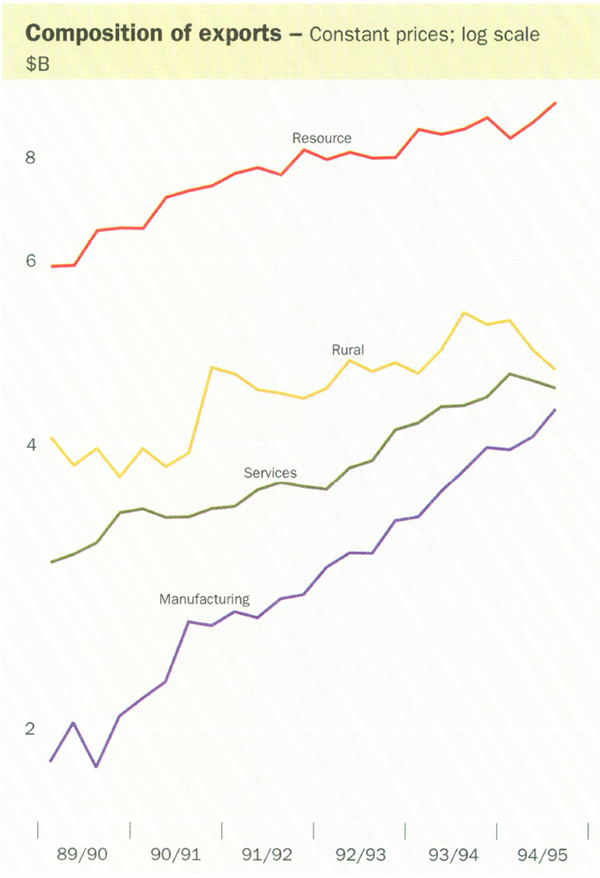
The volume of resource exports increased by around 3 per cent in 1994/95, although prices for key bulk commodities, as measured in foreign currency terms, were lower than in the preceding year. Coal prices were 5 to 8 per cent lower, in US dollar terms, for the 1994/95 Japanese fiscal year (which ended on 31 March) while the US dollar price for iron ore was around 10 per cent lower. Higher coal and iron ore prices have been negotiated for the 1995/96 fiscal year. Coal producers have negotiated price rises of between 12 and 17 per cent in US dollar terms, although at some cost in terms of contract volumes, while iron ore producers have negotiated a price rise of around 7 per cent.
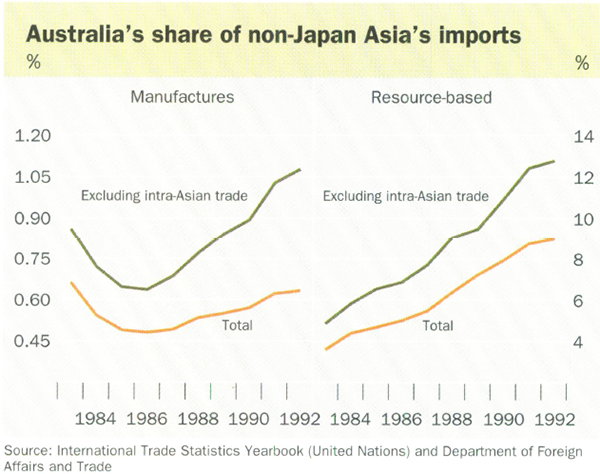
The deficit on net income and transfers rose further in 1994/95, reflecting the effects of the growth in net foreign liabilities, and changes in world interest rates. At the end of 1994/95, the overall servicing cost on foreign liabilities had risen to 4.5 per cent of GDP, a little higher than a year earlier.
The current account deficit totalled $26 billion, around 5¾ per cent of GDP. This compares with an average of 3.5 per cent for the preceding three years, and was about the same as the peaks reached on three other occasions in the 1980s. The widening in the current account deficit implied, once again, increased recourse by Australians to the savings of foreigners. Continuing a trend that has been evident for the past couple of years, much of the inflow was in the form of equity purchases by foreigners, rather than debt. An important difference in 1994/95, however, was that direct investment made up the bulk of the recorded equity inflows. Gross portfolio equity inflows, which were around $16 billion in 1993/94, amounted to less than $3 billion in the nine months to March 1995, presumably reflecting lacklustre domestic equity prices, particularly compared with the strong performance in the US. At the same time there was quite a marked reduction in Australian equity investment abroad, so that net portfolio equity inflows remained large. Non-resident purchases of Australian-dollar-denominated government debt were again substantial, accounting for all of the debt inflows during the year. For the third year in a row, non-resident funding of private sector debt fell, reflecting the corporate sector's ongoing balance sheet restructuring.
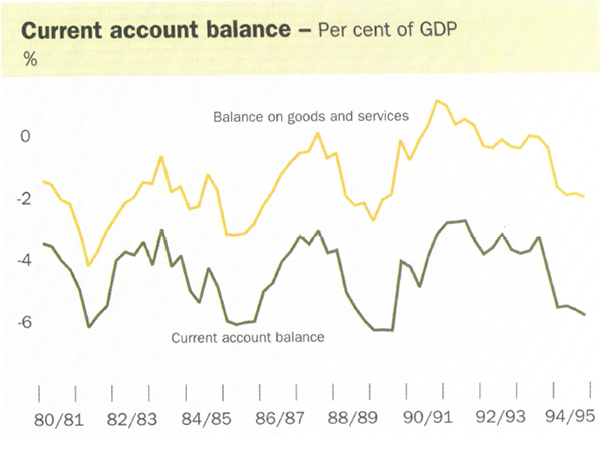
The build-up of debt obligations to foreigners was reflected only gradually in estimates of Australia's net debt position. In the first half of the year, the valuation effects of the appreciation of the Australian dollar largely offset new net foreign borrowing, and the value of net debt obligations hardly changed. Total obligations to foreigners picked up slightly, with strong equity inflows partly offset by falls in Australian share prices. These factors were partially reversed in the second half of the year. The level of net debt at the end of March 1995 was equivalent to around 37 per cent of GDP, slightly lower than at the corresponding time last year. Net foreign liabilities (at 54 per cent) were also a little lower than a year earlier.
Balance of payments
($ billion)
| 1992/93 | 1993/94 | 1994/95 | |
|---|---|---|---|
| Current account | |||
| Balance on goods & services | −1.4 | −1.4 | −8.9 |
| % of GDP | −0.3 | −0.3 | −2.0 |
| Net income & transfers | −13.3 | −15.5 | −17.1 |
| % of GDP | −3.3 | −3.6 | −3.8 |
| Current account balance | −14.7 | −16.8 | −26.1 |
| % of GDP | −3.6 | −3.9 | −5.7 |
| Capital account* | |||
| Equity | 7.1 | 13.9 | 6.9 |
| Portfolio | 5.1 | 12.0 | 4.1 |
| Direct | 1.9 | 1.9 | 2.8 |
| Debt | 8.5 | 3.1 | 3.0 |
| Official | 15.4 | 6.7 | 10.2 |
| Non-official | −6.9 | −3.7 | −7.3 |
| Other | 0.3 | −0.6 | 0.8 |
| Capital account balance | 15.9 | 16.3 | 10.7 |
| Balancing item | −1.3 | 0.4 | 9.0 |
| * The capital account data for 1994/95 are for the nine months to March 1995 | |||
Public finance
Public sector borrowing remained substantial during 1994/95, but declined relative to GDP. In “underlying terms” – that is, excluding the effects of asset sales – the Public Sector Borrowing Requirement is estimated to have been around $16 billion, or 3½ per cent of GDP. Most of this was accounted for by the Commonwealth sector, where the general government deficit was equivalent to about 3¼ per cent of GDP, compared with 4.3 per cent in 1993/94, and 4.7 per cent in 1992/93. At June 1995, net general government debt outstanding is estimated to have been $127 billion, or about 28 per cent of GDP. As a ratio to GDP, this figure, which is one of the lowest among OECD countries, is projected to decline over the next few years as the Federal budget moves into surplus.
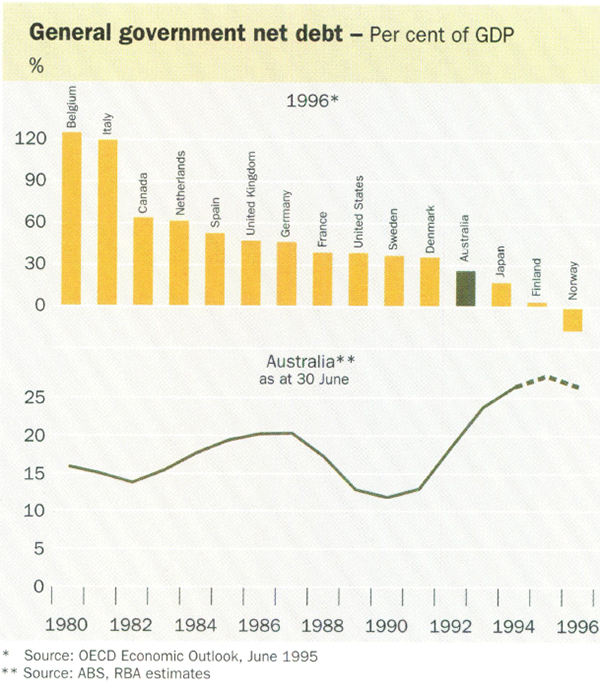
The 1995/96 Federal budget implements a modest tightening of fiscal policy and further consolidates the deficit reduction strategy introduced in the 1993/94 budget. The net effect of policies announced before the budget, measures included in the budget, and post-budget changes in the Senate, is estimated to reduce the structural deficit in 1995/96 by around $2½ billion, about half a percentage point of GDP. In underlying terms, as defined by the ABS, the Commonwealth's borrowing requirement will fall to under 2 per cent of GDP in 1995/96, compared with 3 per cent in 1994/95. On present projections, this improvement will be sustained and strengthened in future years; in underlying terms, the Commonwealth will be in virtual balance in 1996/97 and substantial surplus in later years.
Public sector borrowing requirements*
($ billion)
| 1993/94 | 1994/95 (p) | 1995/96 (e) | |
|---|---|---|---|
| Commonwealth general government | 18.5 | 14.8 | 8.3 |
| % of GDP | 4.3 | 3.2 | 1.7 |
| (Total Commonwealth) | (17.4) | (13.6) | (9.1) |
| (% of GDP) | (4.1) | (3.0) | (1.9) |
| State and local general government | 0.4 | 2.2 | 2.0 |
| % of GDP | 0.1 | 0.5 | 0.4 |
| Public trading enterprises | −3.0 | −1.1 | 0.2 |
| % of GDP | −0.7 | −0.3 | 0.0 |
| Total public sector | 15.8 | 15.8 | 10.6 |
| % of GDP | 3.7 | 3.5 | 2.1 |
| * As defined by ABS – on an underlying basis, excluding asset sales and State debt repayments | |||
The key issue is not so much the size of budget deficits, however defined, but the contribution fiscal policy is making to enhancing public sector saving over the medium term. A long-term downward trend in public saving has been evident over the past 20 years. This was arrested in the late 1980s, and some progress made in reversing it, but the improvement could not be sustained in the economic downturn of the early 1990s. In 1994/95, general government dis-saving represented about 2½ per cent of GDP and helped to keep national saving overall at historical lows.
The recent budget made some substantial steps towards raising national saving. In addition to the projected improvement in public finances over the coming years, the Government announced plans to boost private saving through increased superannuation contributions of employees, and through the redirection of tax cuts scheduled for 1998/99 to matching superannuation contributions for low and middle-income earners. These measures, provided they are fully followed through, will do a lot to increase saving by Australians by the beginning of the next decade. Their successful implementation is central to the task of lifting national saving to levels consistent with maintaining strong investment without large current account deficits. The benefits are, however, some years away and will require ongoing efforts to hold the line on the budget balance and to see that the projected increases in private savings are delivered. In the interim, shortfalls in savings will have to be met from foreign capital inflows with, as the counterpart of this, some further relatively large current account deficits.
In time, the benefit of greater national saving should be seen in an improvement in the current account deficit. The current account deficit represents the excess of spending by Australians over what we produce. Australians must not only produce more: we must, as well, save more to narrow the gap between expenditure and production. Narrowing that gap is the basic pre-condition for reducing the current account deficit. At the same time, production needs to be re-oriented towards the tradeable sector, both to expand exports and to replace imports.
Monetary policy: the outlook
The current recovery in economic activity has been under way for four years. Most sectors of the economy have experienced an improvement in conditions during that time. Much of the earlier slack in capacity utilisation has been wound back and unemployment has fallen, although it remains too high.
Over the past year, it was necessary to seek some slowing in growth, to bring spending more into line with the economy's capacity to produce in a sustainable way. Policy changes to this end were put in place. Adjustments of interest rates – and of fiscal and other policy instruments for that matter – do not produce finely calibrated effects, and experience cautions against expecting policy-makers to be able to fine-tune economic developments. To this point, however, policy has been successful in slowing growth from what was clearly an unsustainable pace, to a rate consistent with the economy's sustainable growth path. This more moderate growth will slow progress in reducing unemployment, but the exceptional rate of reduction over the past two years could not have been sustained. More moderate growth will help to contain the cost pressures stemming from the rapid growth in 1994, and the lower exchange rate in the first half of 1995, which are making their way through the economy.
In this environment, finding the appropriate balance between the activity and inflation objectives of monetary policy remains a challenging task. There are risks both ways. Activity is slowing, as it needed to, but there is no reason at this time to believe that it will continue to slide in any sustained way. Indeed, given some improvement in the outlooks for the US and Japanese economies in 1996, and the prospect of a good recovery in the domestic rural sector, activity over the next year or so is more likely to bounce back than fall away. Inflation is likely to increase over the coming year, although it is less clear at the moment whether any such increase will be temporary, with underlying inflation returning to 2–3 per cent over a reasonable period.
The balancing of these and other risks for activity and prices will be the key focus for monetary policy over the coming year. In the Bank's judgment, policy is presently well-positioned to respond as necessary to the evolving economic situation.